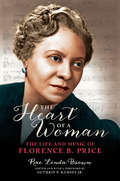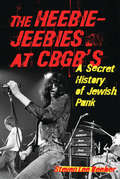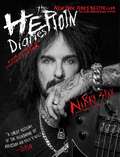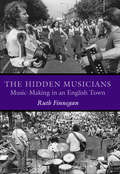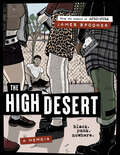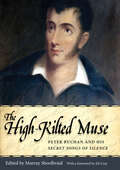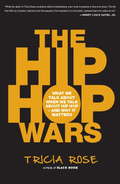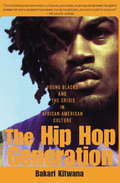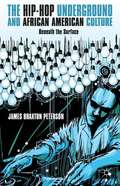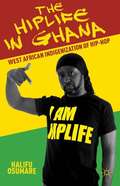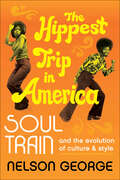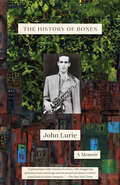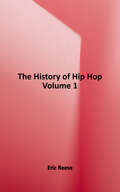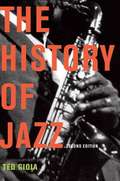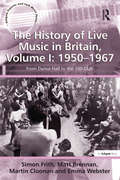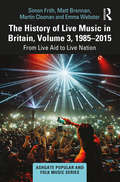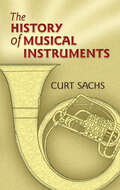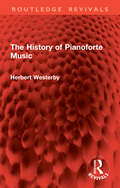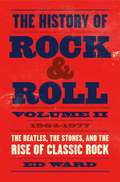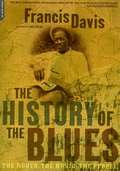- Table View
- List View
The Heart of a Woman: The Life and Music of Florence B. Price (Music in American Life)
by Rae Linda BrownThe Heart of a Woman offers the first-ever biography of Florence B. Price, a composer whose career spanned both the Harlem and Chicago Renaissances, and the first African American woman to gain national recognition for her works. Price's twenty-five years in Chicago formed the core of a working life that saw her create three hundred works in diverse genres, including symphonies and orchestral suites, art songs, vocal and choral music, and arrangements of spirituals. Through interviews and a wealth of material from public and private archives, Rae Linda Brown illuminates Price's major works while exploring the considerable depth of her achievement. Brown also traces the life of the extremely private individual from her childhood in Little Rock through her time at the New England Conservatory, her extensive teaching, and her struggles with racism, poverty, and professional jealousies. In addition, Brown provides musicians and scholars with dozens of musical examples.
The Heebie-Jeebies at CBGB's: A Secret History of Jewish Punk
by Steven BeeberBased in part on the recent interviews with more than 125 people --among them Tommy Ramone, Chris Stein (Blondie), Lenny Kaye (Patti Smith Group), Hilly Kristal (CBGBs owner), and John Zorn--this book focuses on punk's beginnings in New York City to show that punk was the most Jewish of rock movements, in both makeup and attitude. As it originated in Manhattan's Lower East Side in the early 1970s, punk rock was the apotheosis of a Jewish cultural tradition that found its ultimate expression in the generation born after the Holocaust. Beginning with Lenny Bruce, "the patron saint of punk," and following pre-punk progenitors such as Lou Reed, Jonathan Richman, Suicide, and the Dictators, this fascinating mixture of biography, cultural studies, and musical analysis delves into the lives of these and other Jewish punks--including Richard Hell and Joey Ramone--to create a fascinating historical overview of the scene. Reflecting the irony, romanticism, and, above all, the humor of the Jewish experience, this tale of changing Jewish identity in America reveals the conscious and unconscious forces that drove New York Jewish rockers to reinvent themselves--and popular music.
The Helmholtz Legacy in Physiological Acoustics
by Erwin HiebertThis book explores the interactions between science and music in the late nineteenth- and early twentieth century. It examines and evaluates the work of Hermann von Helmholtz, Max Planck, Shohé Tanaka, and Adriaan Fokker, leading physicists and physiologists who were committed to understanding crucial aesthetic components of the art of music, including the standardization of pitch and the implementation of various types of intonations. With a mixture of physics, physiology, and aesthetics, author Erwin Hiebert addresses throughout the book how just intonation came to intersect with the history of keyboard instruments and exert an influence on the development of Western music. He begins with the work of Hermann von Helmholtz, a leading nineteenth-century physicist and physiologist who not only made important contributions in vision, optics, electrodynamics and thermodynamics, but also helped advanced the field of music theory as well. The author traces the Helmholtzian trends of thought that become inherently more complex by reaching beyond the sciences to perform a bridge with aesthetics and the diverse ways in which the human mind interprets or is taught, in different cultures, to interpret and understand music. Next, the author explores the works of other key physicists and physiologists who were influenced by Helmholtz and added to his legacy. He examines Japanese music theory student Shohé Tanaka, who sought to design a harmonium that was not based on equal temperament but rather on just intonation. Dutch physicist Adriaan Daniel Fokker, who arranged for organs to be built based on 31-tones per octave, orchestrated concerts for these new instruments and even attempted to compose microtonal music, or music whose tonality is based on intervals smaller than the typical twelve semitones of Western music.
The Hero And the Blues
by Albert MurrayIn this visionary book, the author of the legendary Stomping the Blues takes an audacious new look at black music and, in the process, succeeds in changing the way we read all literature. Albert Murray's subject is the previously unacknowledged kinship between fiction and the blues. Both, he argues, are virtuoso performances that impart information, wisdom, and moral guidance to their audiences. Both place a high value on improvisation. And both fiction and the blues create a delicate balance between the holy and the obscene, essential human values and cosmic absurdity. Encompassing artists from Ernest Hemingway to Duke Ellington, and from Thomas Mann to Richard Wright, The Hero and the Blues is at once an homage and a manifesto for a new black aesthetic. Erudite, eloquent, appreciative, and iconoclastic, it is further evidence of Murray's ability to turn the essay into a kind of poetry -- as enchanting as it is instructive.
The Hero In You
by Angela Padron Ellis PaulAcclaimed songwriter Ellis Paul brings the inspirational words from his songs to the pages of a new picture book! Based on his award-winning family album of the same name, The Hero in You introduces kids to thirteen real-life American heroes. From Chief Joseph to Rosa Parks, their remarkable, heroic lives motivate and encourage us to aim high and try our best. Also included is a special edition CD of The Hero in You with 14 songs and exclusive introductory tracks from Ellis Paul. Readers can listen along to the lyrical book text, then read additional facts about the heroes on each spread.
The Heroin Diaries: A Year in the Life of a Shattered Rock Star
by Nikki SixxIn one of the most unique memoirs of addiction ever published, MÖtley CrÜe's Nikki Sixx shares mesmerizing diary entries from the year he spiraled out of control in a haze of heroin and cocaine, presented alongside riveting commentary from people who were there at the time, and from Nikki himself. When MÖtley CrÜe was at the height of its fame, there wasn't any drug Nikki Sixx wouldn't do. He spent days -- sometimes alone, sometimes with other addicts, friends, and lovers -- in a coke and heroin-fueled daze. The highs were high, and Nikki's journal entries reveal some euphoria and joy. But the lows were lower, often ending with Nikki in his closet, surrounded by drug paraphernalia and wrapped in paranoid delusions. Here, Nikki shares those diary entries -- some poetic, some scatterbrained, some bizarre -- and reflects on that time. Joining him are Tommy Lee, Vince Neil, Mick Mars, Slash, Rick Nielsen, Bob Rock, and a host of ex-managers, ex-lovers, and more. Brutally honest, utterly riveting, and shockingly moving, The Heroin Diaries follows Nikki during the year he plunged to rock bottom -- and his courageous decision to pick himself up and start living again.
The Hidden Musicians: Music-Making in an English Town (Music Culture)
by Ruth FinneganA landmark in the study of music and culture, this acclaimed volume documents the remarkable scope of amateur music-making in the English town of Milton Keynes. It presents in vivid detail the contrasting yet overlapping worlds of classical orchestras, church choirs, brass bands, amateur operatic societies, and amateur bands playing jazz, rock, folk, and country. Notable for its contribution to wider theoretical debates and its influential challenge to long-held assumptions about music and how to study it, the book focuses on the practices rather than the texts or theory of music, rejecting the idea that only selected musical traditions, "great names," or professional musicians are worth studying. This opens the door to the invisible work put in by thousands of local people of diverse backgrounds, and how the pathways creatively trodden by amateur musicians have something to tell us about both urban living and what it is to be human. Now with a new preface by the author, this long-awaited reissue of The Hidden Musicians will bring its insights and innovations to a new generation of students and scholars.
The High Desert: Black. Punk. Nowhere.
by James SpoonerA formative coming-of-age graphic memoir by the creator of Afro-punk: a young man’s immersive reckoning with identity, racism, clumsy teen love and belonging in an isolated California desert, and a search for salvation and community through punk. Apple Valley, California, in the late eighties, a thirsty, miserable desert. Teenage James Spooner hates that he and his mom are back in town after years away. The one silver lining—new school, new you, right? But the few Black kids at school seem to be gangbanging, and the other kids fall on a spectrum of micro-aggressors to future Neo-Nazis. Mixed race, acutely aware of his Blackness, James doesn't know where he fits until he meets Ty, a young Black punk who introduces him to the school outsiders—skaters, unhappy young rebels, caught up in the punk groundswell sweeping the country. A haircut, a few Sex Pistols, Misfits and Black Flag records later: suddenly, James has friends, romantic prospects, and knows the difference between a bass and a guitar. But this desolate landscape hides brutal, building undercurrents: a classmate overdoses, a friend must prove himself to his white supremacist brother and the local Aryan brotherhood through a show of violence. Everything and everyone are set to collide at one of the year's biggest shows in town... Weaving in the Black roots of punk rock and a vivid interlude in the thriving eighties DIY scene in New York's East Village, this is the memoir of a budding punk, artist, and activist.
The High-Kilted Muse: Peter Buchan and His Secret Songs of Silence
by Murray ShoolbraidIn 1832 the Scottish ballad collector Peter Buchan of Peterhead, Aberdeenshire, presented an anthology of risqué‚ and convivial songs and ballads to a Highland laird. When Professor Francis James Child of Harvard was preparing his magisterial edition of The English and Scottish Popular Ballads, he made inquiries about it, but it was not made available in time to be considered for his work. On his death it was presented to the Child Memorial Library at Harvard. Because of its unseemly materials, the manuscript languished there since, unprinted, though referred to now and again, and a few items from time to time made an appearance. The manuscript has now been transcribed with full annotation and with an introduction on the compiler, his times, and the Scottish bawdy tradition. It contains the texts (without tunes) of seventy-six bawdy songs and ballads, along with a long-lost scatological poem attributed to the Edinburgh writer James “Balloon” Tytler. Appendices give details of Buchan's two published collections of ballads. Additionally, there is a list of tale types and motifs, a glossary of Scots and archaic words, a bibliography, and an index. The High-Kilted Muse brings to light a long-suppressed volume and fills in a great gap in published bawdy songs and ballads.
The Hip Hop Wars: What We Talk About When We Talk About Hip Hop--and Why It Matters
by Tricia RoseHip-hop is in crisis. For the past dozen years, the most commercially successful hip-hop has become increasingly saturated with caricatures of black gangstas, thugs, pimps, and 'hos. The controversy surrounding hip-hop is worth attending to and examining with a critical eye because, as scholar and cultural critic Tricia Rose argues, hip-hop has become a primary means by which we talk about race in the United States.In The Hip-Hop Wars, Rose explores the most crucial issues underlying the polarized claims on each side of the debate: Does hip-hop cause violence, or merely reflect a violent ghetto culture? Is hip-hop sexist, or are its detractors simply anti-sex? Does the portrayal of black culture in hip-hop undermine black advancement?A potent exploration of a divisive and important subject, The Hip-Hop Wars concludes with a call for the regalvanization of the progressive and creative heart of hip-hop. What Rose calls for is not a sanitized vision of the form, but one that more accurately reflects a much richer space of culture, politics, anger, and yes, sex, than the current ubiquitous images in sound and video currently provide.
The Hip-Hop Generation: Young Blacks and the Crisis in African-American Culture
by KitwanaThe Hip Hop Generation is an eloquent testament for black youth culture at the turn of the century. The only in-depth study of the first generation to grow up in post-segregation America, it combines culture and politics into a pivotal work in American studies. Bakari Kitwana, one of black America's sharpest young critics, offers a sobering look at this generation's disproportionate social and political troubles, and celebrates the activism and politics that may herald the beginning of a new phase of African-American empowerment.
The Hip-hop Underground And African American Culture
by James Braxton PetersonThe underground is a multi-faceted concept in African American culture. Peterson uses Richard Wright, KRS-One, Thelonius Monk, and the tradition of the Underground Railroad to explore the manifestations and the attributes of the underground within the context of a more panoramic picture of African American expressivity within hip-hop.
The Hiplife in Ghana
by Halifu OsumareThe Hiplife in Ghana explores one international site - Ghana, West Africa - where hip-hop music and culture have morphed over two decades into the hiplife genre of world music. It investigates hiplife music not merely as an imitation and adaptation of hip-hop, but as a reinvention of Ghana's century-old highlife popular music tradition. Author Halifu Osumare traces the process by which local hiplife artists have evolved a five-phased indigenization process that has facilitated a youth-driven transformation of Ghanaian society. She also reveals how Ghana's social shifts, facilitated by hiplife, have occurred within the country's 'corporate recolonization,' serving as another example of the neoliberal free market agenda as a new form of colonialism. Hiplife artists, we discover, are complicit with these global socio-economic forces even as they create counter-narratives that push aesthetic limits and challenge the neoliberal order.
The Hippest Trip in America: Soul Train and the Evolution of Culture & Style
by Nelson GeorgeAn authoritative history of the groundbreaking syndicated television show that has become an icon of American pop culture, from acclaimed author and filmmaker Nelson George, “the most accomplished black music critic of his generation” (Washington Post Book World).When it debuted in October 1971, seven years after the Civil Rights Act, Soul Train boldly went where no variety show had gone before, showcasing the cultural preferences of young African-Americans and the sounds that defined their lives: R&B, funk, jazz, disco, and gospel music. The brainchild of radio announcer Don Cornelius, the show’s producer and host, Soul Train featured a diverse range of stars, from James Brown and David Bowie to Christine Aguilera and R. Kelly; Marvin Gaye and Elton John to the New Kids on the Block and Stevie Wonder.The Hippest Trip in America tells the full story of this pop culture phenomenon that appealed not only to blacks, but to a wide crossover audience as well. Famous dancers like Rosie Perez and Jody Watley, performers such as Aretha Franklin, Al Green, and Barry White, and Cornelius himself share their memories, offering insights into the show and its time—a period of extraordinary social and political change. Colorful and pulsating, The Hippest Trip In America is a fascinating portrait of a revered cultural institution that has left an indelible mark on our national consciousness.
The History of Bones: A Memoir
by John LurieThe quintessential depiction of 1980s New York and the downtown scene from the artist, actor, musician, and composer John Lurie&“Ferocious and wise, funny and tragic, raging and forgiving, and I loved every page.&”—Nick Flynn, author of Another Bullshit Night in Suck CityIn the tornado that was downtown New York in the 1980s, John Lurie stood at the vortex. After founding the band The Lounge Lizards with his brother, Evan, in 1979, Lurie quickly became a centrifugal figure in the world of outsider artists, cutting-edge filmmakers, and cultural rebels. Now Lurie vibrantly brings to life the whole wash of 1980s New York as he developed his artistic soul over the course of the decade and came into orbit with all the prominent artists of that time and place, including Andy Warhol, Debbie Harry, Boris Policeband, and, especially, Jean-Michel Basquiat, the enigmatic prodigy who spent a year sleeping on the floor of Lurie&’s East Third Street apartment. It may feel like Disney World now, but in The History of Bones, the East Village, through Lurie&’s clear-eyed reminiscence, comes to teeming, gritty life. The book is full of grime and frank humor—Lurie holds nothing back in this journey to one of the most significant moments in our cultural history, one whose reverberations are still strongly felt today. History may repeat itself, but the way downtown New York happened in the 1980s will never happen again. Luckily, through this beautiful memoir, we all have a front-row seat.
The History of Hip Hop
by Eric ReeseHip Hop Truth for the Art and Pulse of America! This cultural brilliance of sound presented a voice and mindset detailing life growing up in the streets of America's largest urban populations of color going as far back as the 1920s. Sprung from the spirits of hustle and grime, this culture quickly uncovered an amazing bunch of fresh African American forces of nature eager to express their street accounts and contribute to a spirited new style of soul of black Americana across the globe .Today, Hip Hop has reached the doorsteps of just about everywhere on the planet and played at each venue imaginable. In this book, I provide you with an elementary perspective of the following: Differences between what is Hip-Hop and Rap Hip Hop's earliest influences Explanation of what constitutes Hip Hop and Rap Culture Underground Rap and why it's the core of the genre Myths & Theories Greatest moments in hip hop history Research in Hip Hop's Genres Hip Hop's Global Impact and much more... As this music legacy continues to expand its sway, know for sure it's here to stay. This History of Hip Hop Series give you the very history of the indisputable force of urban artists and their deejays. Hip Hop lives on! Press Buy Now and learn about one of the greatest music legacies of American music today!
The History of Jazz
by Ted Gioia<p>Ted Gioia's History of Jazz has been universally hailed as a classic--acclaimed by jazz critics and fans around the world. Now Gioia brings his magnificent work completely up-to-date, drawing on the latest research and revisiting virtually every aspect of the music, past and present. <p>Gioia tells the story of jazz as it had never been told before, in a book that brilliantly portrays the legendary jazz players, the breakthrough styles, and the world in which it evolved. Here are the giants of jazz and the great moments of jazz history--Jelly Roll Morton, Louis Armstrong, Duke Ellington at the Cotton Club, cool jazz greats such as Gerry Mulligan, Stan Getz, and Lester Young, Charlie Parker and Dizzy Gillespie's advocacy of modern jazz in the 1940s, Miles Davis's 1955 performance at the Newport Jazz Festival, Ornette Coleman's experiments with atonality, Pat Metheny's visionary extension of jazz-rock fusion, the contemporary sounds of Wynton Marsalis, and the post-modernists of the current day. Gioia provides the reader with lively portraits of these and many other great musicians, intertwined with vibrant commentary on the music they created. He also evokes the many worlds of jazz, taking the reader to the swamp lands of the Mississippi Delta, the bawdy houses of New Orleans, the rent parties of Harlem, the speakeasies of Chicago during the Jazz Age, the after hours spots of corrupt Kansas city, the Cotton Club, the Savoy, and the other locales where the history of jazz was made. And as he traces the spread of this protean form, Gioia provides much insight into the social context in which the music was born.</p>
The History of Live Music in Britain, Volume I: From Dance Hall to the 100 Club (Ashgate Popular and Folk Music Series)
by Simon Frith Matt Brennan Martin Cloonan Emma WebsterThe social history of music in Britain since 1950 has long been the subject of nostalgic articles in newspapers and magazines, nostalgic programmes on radio and television and collective memories on music websites, but to date there has been no proper scholarly study. The three volumes of The History of Live Music in Britain address this gap, and do so from the unique perspective of the music promoter: the key theme is the changing nature of the live music industry. The books are focused upon popular music but cover all musical genres and the authors offer new insights into a variety of issues, including changes in musical fashions and tastes; the impact of developing technologies; the balance of power between live and recorded music businesses; the role of the state as regulator and promoter; the effects of demographic and other social changes on music culture; and the continuing importance of do-it-yourself enthusiasts. Drawing on archival research, a wide range of academic and non-academic secondary sources, participant observation and industry interviews, the books are likely to become landmark works within Popular Music Studies and broader cultural history.
The History of Live Music in Britain, Volume II, 1968-1984: From Hyde Park to the Hacienda (Ashgate Popular and Folk Music Series)
by Simon Frith Matt Brennan Martin Cloonan Emma WebsterTo date, there has been a significant gap in work on the social history of music in Britain from 1950 to the present day. The three volumes of Live Music in Britain address this gap and do so through a unique prism—that of live music. The key theme of the books is the changing nature of the live music industry in the UK, focused upon popular music but including all musical genres. Via this focus, the books offer new insights into a number of other areas, including the relationship between commercial and public funding of music, changing musical fashions and tastes, the impact of changing technologies, the changing balance of power within the music industries, the role of the state in regulating and promoting various musical activities within an increasingly globalised music economy, and the effects of demographic and other social changes on music culture. Drawing on new archival research, a wide range of academic and non-academic secondary sources, participant observation and a series of interviews with key personnel, the books have the potential to become landmark works within Popular Music Studies and broader cultural history. The second volume covers the period from Hyde Park to the Hacienda (1968–84).
The History of Live Music in Britain, Volume III, 1985-2015: From Live Aid to Live Nation (Ashgate Popular and Folk Music Series)
by Simon Frith Matt Brennan Martin Cloonan Emma WebsterTo date there has been a significant gap in existing knowledge about the social history of music in Britain from 1950 to the present day. The three volumes of Live Music in Britain address this gap and do so through a unique prism—that of live music. The key theme of the books is the changing nature of the live music industry in the UK, focused upon popular music but including all musical genres. Via this focus, the books offer new insights into a number of other areas including the relationship between commercial and public funding of music; changing musical fashions and tastes; the impact of changing technologies; the changing balance of power within the music industries; the role of the state in regulating and promoting various musical activities within an increasingly globalised music economy; and the effects of demographic and other social changes on music culture. Drawing on new archival research, a wide range of academic and non- academic secondary sources, participant observation and a series of interviews with key personnel, the books have the potential to become landmark works within Popular Music Studies and broader cultural history. The third volume covers the period from Live Aid to Live Nation (1985– 2015).
The History of Musical Instruments
by Curt SachsThis first comprehensive history of musical instruments, this book ranges from prehistoric times to the 20th century. It traverses five continents and every stage of evolution, from primitive rattles and bull-roarers to the electric organ. Author Curt Sachs, one of the world's most distinguished musicologists, combines rich scholarship with personal insight in a remarkable fusion of music, anthropology, and the fine arts.Beginning with the earliest manifestations of rhythm, Sachs explores the association of sound with primitive rites of fertility, life, death, and rebirth. He traces the evolution of folk and ritual instruments to tools of entertainment and art, the rise of a professional class of singers and musicians, and the musical revolution that flowered during the Renaissance. Sachs chronicles the foundation of the modern orchestra during the baroque period and its subsequent development, concluding with the modern-day rise of electric and jazz instruments.A pleasure to read as well as a valuable resource, this classic work is enhanced with 24 plates and 167 illustrations.
The History of Pianoforte Music (Routledge Revivals)
by Herbert WesterbyOriginally published in 1924, and authored by a renowned pianist and musicologist, this book is a comprehensive study of the history and evolution of pianoforte music from its origins in the early 18th century to modern times. The book begins with a discussion of sixteenth-century English composers for the virginal. Special emphasis is given to works of the Romantic period and to national styles of piano music such as those of Chopin and the Polish school, Liszt and Magyar music, and Cesar Franck and music of The Netherlands. The book provides a bibliography and lists of major collective editions, publishers of piano music throughout the world, and journals for pianists.
The History of Rock & Roll, Volume 2: 1964–1977: The Beatles, the Stones, and the Rise of Classic Rock
by Ed WardFrom rock and roll historian Ed Ward comes a comprehensive, authoritative, and enthralling cultural history of one of rock's most exciting eras.It's February 1964 and The Beatles just landed in New York City, where the NYPD, swarms of fans, and a crowd of two hundred journalists await their first American press conference. It begins with the question on everyone's mind: "Are you going to get a haircut in America?" and ends with a reporter tugging Paul McCartney's hair in an attempt to remove his nonexistent wig. This is where The History of Rock & Roll, Volume 2 kicks off. Chronicling the years 1964 through the mid-1970s, this latest volume covers one of the most exciting eras of rock history, which saw a massive outpouring of popular and cutting-edge music.Ward weaves together an unputdownable narrative told through colorful anecdotes and shares the behind-the-scenes stories of the megastars, the trailblazers, DJs, record executives, concert promoters, and producers who were at the forefront of this incredible period in music history. From Bob Dylan to Bill Graham, Jimi Hendrix, Janis Joplin, The Byrds, Aretha Franklin, The Rolling Stones, and more, everyone's favorite musicians of the era make an appearance in this sweeping history that reveals how the different players, sounds, and trends came together to create the music we all know and love today.
The History of the Blues: The Roots, The Music, The People
by Francis DavisFrancis Davis's The History of the Blues is a groundbreaking rethinking of the blues that fearlessly examines how race relations have altered perceptions of the music. Tracing its origins from the Mississippi Delta to its amplification in Chicago right after World War II, Davis argues for an examination of the blues in its own right, not just as a precursor to jazz and rock 'n' roll. The lives of major figures such as Robert Johnson, Charlie Patton, and Leadbelly, in addition to contemporary artists such as Stevie Ray Vaughan and Robert Cray, are examined and skillfully woven into a riveting, provocative narrative.
The History of the Erard Piano and Harp in Letters and Documents, 1785-1959
by Robert Adelson Alain Roudier Jenny Nex Laure Barthel Michel Foussard Robert Adelson Alain Roudier Jenny Nex Laure BarthelSébastien Erard and the firm that carried his name are seminal in the history of musical instruments. Erard's inventions - especially the double escapement for the piano and the double-action for the harp - have had an enormous impact on instruments and musical life and are still at the foundation of piano and harp building today. The recently discovered archives of the Erard piano and harp building firm are perhaps the largest and most complete record of musical instrument making anywhere, containing never-before-published correspondence from musicians including Mendelssohn, Liszt and Fauré. These volumes present the archive's records and documents in two parts, the first relating to inventions, business, composers and performers and the second to the Erard family correspondence. In both the original French and with English translations, the documents offer fascinating insights into the musical landscape of Europe from the start of Erard's career in 1785 to the closure of the firm in 1959.
